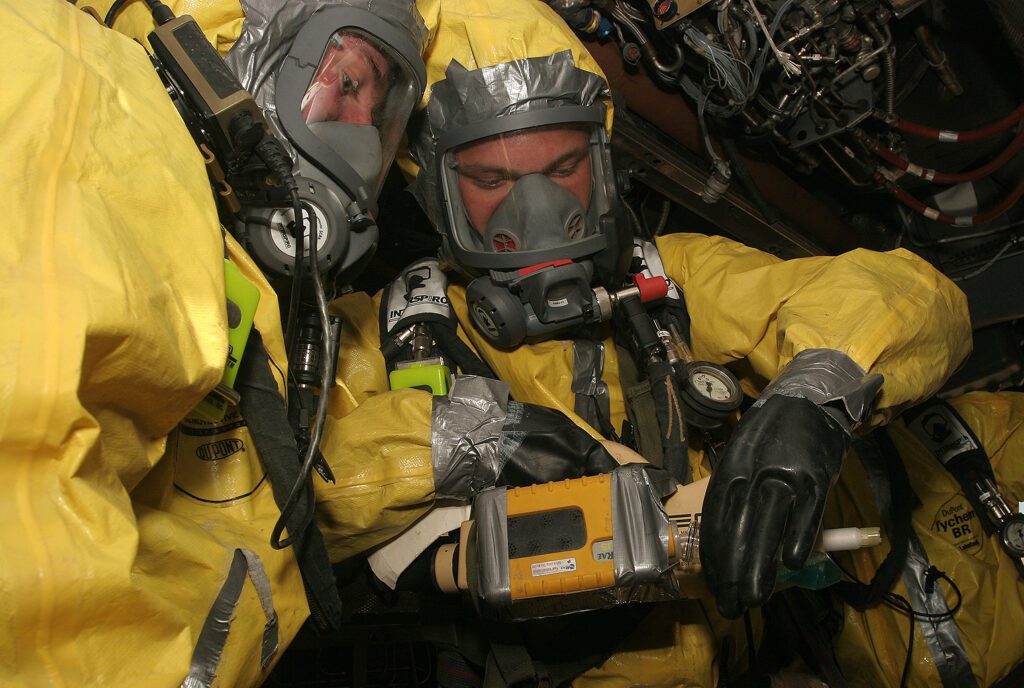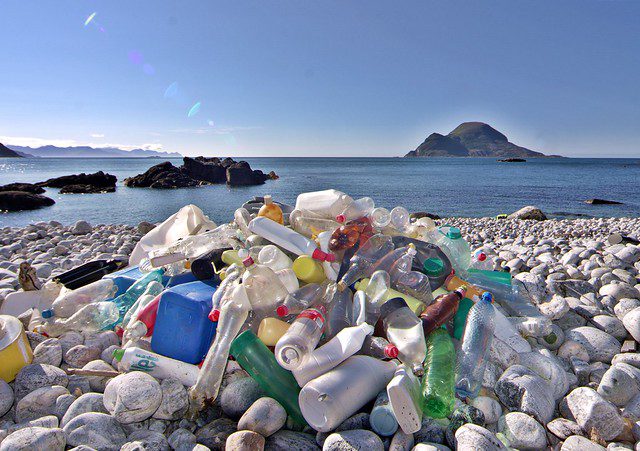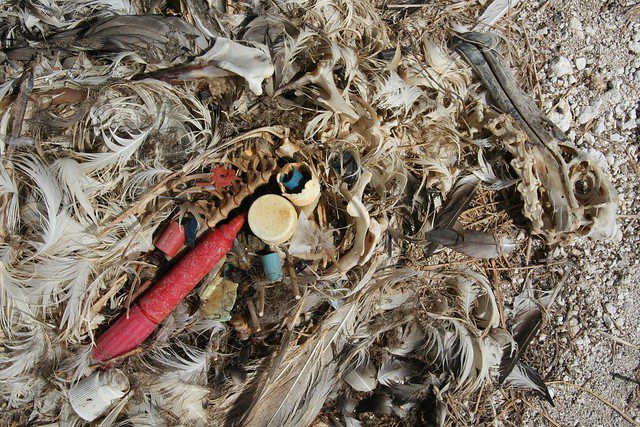
American veterans poisoned at Camp Lejeune can finally seek justice, thanks to a new law.
By Jonathan Sharp, Independent Media Institute
6 min read
Camp Lejeune, a military base in Jacksonville, North Carolina, was established in 1942 to train future Marines for World War II. While it is known as the home of “Expeditionary Forces in Readiness,” the facility also has a long history of contamination with toxic chemicals such as perchloroethylene, vinyl chloride, trichloroethylene, and benzene. In 1982, volatile organic compounds—gasses released by these solvents—were found at Camp Lejeune.
Furthermore, since 1966, military firefighters and trainees have been using the fire suppressant known as Aqueous Film Forming Foam (AFFF) to extinguish jet fuel and petroleum fires, which only worsened pollution. This firefighting foam contains PFAS, a group of over 5,000 dangerous substances often dubbed “forever chemicals,” in a concentration of up to 98 percent. With each use, AFFF contaminates the environment with these chemicals. Some take over a thousand years to break down, hence their nickname.
The highest PFAS level at Camp Lejeune was 170,000 parts per trillion, which exceeds the safe exposure limit by 2,450 times. Currently, at least 14 sites of Camp Lejeune where these chemicals lurk, despite the relentless cleanup endeavors of the Environmental Protection Agency and the Navy. Because PFAS are extremely difficult to remove from the environment, the military base is expected to be completely safe within a few decades.
In 1985, the greatest trichloroethylene level was 280 times over the safe exposure limit, whereas the highest perchloroethylene level eclipsed the safe exposure limit by 43 times. The dry-cleaning firm ABC One-Hour Cleaners was responsible for perchloroethylene contamination. As for the other industrial solvents, they ended up polluting Camp Lejeune as a result of the military recklessly using these chemicals to clean weapons and equipment.
Exposure to toxic chemicals may cause debilitating health problems, including liver cancer, renal toxicity, prostate cancer, leukemia, female infertility, pancreatic cancer, and scleroderma. Between 1953 and 1987, roughly one million people lived at Camp Lejeune, and all had a high risk of developing severe disease. Until recently, veterans affected by toxic exposure could only receive benefits from the U.S. Department of Veterans Affairs (VA). Today, due to the Camp Lejeune Justice Act, they can also obtain financial compensation from the U.S. government.
VA Keeps Rejection Rate High for Camp Lejeune Vets
The VA had been aware of the horrific diseases veterans might contract at Camp Lejeune since the beginning. Still, it was only in 2012 that Congress passed the Honoring America’s Veterans and Caring for Camp Lejeune Families Act. This comprehensive, bipartisan legislative package was meant to grant veterans and family members who lived at the military base access to better healthcare, education, housing, and memorial services, as well as disability, social security, and indemnity compensation.
A decade ago, veterans were able to file disability compensation claims for health problems stemming from toxic exposure at military bases. Nevertheless, the VA began using alleged “subject matter experts” in 2012 to review these cases. Recently, the fact that these “experts” were nothing but general and preventive doctors with no proper expertise in assessing the complex afflictions Camp Lejeune veterans were struggling with came to light. Due to their lack of knowledge, the claim approval rate abruptly plummeted from 25 percent to only 5 percent.
In 2017, the VA deemed eight diseases as presumptive conditions resulting from Camp Lejeune’s toxic contamination, slightly increasing the claim approval rate to roughly 17 percent over the last decade. Nonetheless, this is still below the former average, and thousands of veterans suffering from terrible diseases are regularly denied the compensation and healthcare services they deserve. While veterans acknowledged the significance of this minor improvement, they believed the list should include a broader range of health problems.
Currently, the VA’s list of health issues related to toxic exposure at Camp Lejeune includes the eight presumptive conditions, but also 15 conditions for which veterans and family members will receive financial compensation to cover the costs of their healthcare and treatment. Filing a claim for VA disability compensation as a Camp Lejeune veteran is significant. After a medical evaluation, those assigned a 100 percent disability rating will receive monthly compensation of over $3,000. Additionally, veterans impacted by toxic exposure can now obtain financial compensation from the U.S. government due to the Camp Lejeune Justice Act.
How the Camp Lejeune Justice Act 2022 Can Help Veterans Impacted by Toxic Exposure
On March 26, 2021, Representative Matt Cartwright (D-PA) introduced the Camp Lejeune Justice Act bill. The goal of the bill is to allow veterans, military families, and civilians who lived at the military installation between August 1, 1953, and December 31, 1987, for at least one month to seek reparations outside the Department of Veterans Affairs. Furthermore, the Camp Lejeune Justice Act prohibits the U.S. government from asserting immunity from litigation in response to the claims filed by toxic exposure victims.
“When we send our men and women overseas, we make a promise to care for them when they come home. We failed our veterans […], and it is up to us to make it right. Our bipartisan bill […] eliminates burdensome red tape to ensure that those exposed to toxic chemicals, including servicemembers, Marine dependents, civil servants, and contractors, can receive their day in court,” said Representative Greg Murphy (R-NC), a supporter of the Camp Lejeune Justice Act. To put it differently, the bill enables veterans to exercise their constitutional right to legal recourse.
On August 2, 2022, the Senate voted to pass the bill with a final vote of 86-11. Nine days later, President Joe Biden signed the Camp Lejeune Justice Act into law. The bill is now part of the Honoring Our PACT Act, which is meant to improve healthcare access and funding for veterans exposed to toxic substances during their military service. According to the Camp Lejeune Justice Act, the U.S. District Court for the Eastern District of North Carolina has exclusive jurisdiction over any claim filed by toxic exposure victims.
“After years of commitment to this issue, I am grateful that my colleagues on both sides of the aisle agreed to pass this crucial legislation so that poisoned Camp Lejeune veterans can finally seek justice,” said Rep. Cartwright. It is worthy of note that punitive damages will not be awarded in any lawsuit under this new law. Therefore, veterans struggling with health problems caused by toxic exposure at Camp Lejeune can only receive financial compensation from the federal government. The settlement payout ranges between $25,000 and $1 million, depending on the severity of the plaintiff’s diagnosis.
Before the Camp Lejeune Justice Act became law, veterans could only receive disability compensation and healthcare benefits from the Veterans Affairs, while civilians had no right to legal recourse. The cost of treatment for the crippling diseases toxic exposure victims suffer from is exceptionally high—for instance, people with thyroid cancer usually have to pay up to $40,000 for surgery. Consequently, veterans and civilians who spent time at Camp Lejeune have been struggling financially. Even though money will not cure most of the health issues toxic exposure victims develop, the financial compensation they can obtain will be of tremendous help.
###
Jonathan Sharp is the chief financial officer at Environmental Litigation Group, PC. Headquartered in Birmingham, Alabama, the law firm specializes in toxic exposure cases for veterans and their families.
Earth | Food | Life (EFL) explores the critical and often interconnected issues facing the climate/environment, food/agriculture, and nature/animal rights, and champions action; specifically, how responsible citizens, voters, and consumers can help put society on an ethical path of sustainability that respects the rights of all species who call this planet home. EFL emphasizes the idea that everything is connected, so every decision matters.
Click here to support the work of EFL and the Independent Media Institute.
Questions, comments, suggestions, submissions? Contact EFL editor Reynard Loki at [email protected]. Follow EFL on Twitter @EarthFoodLife.




